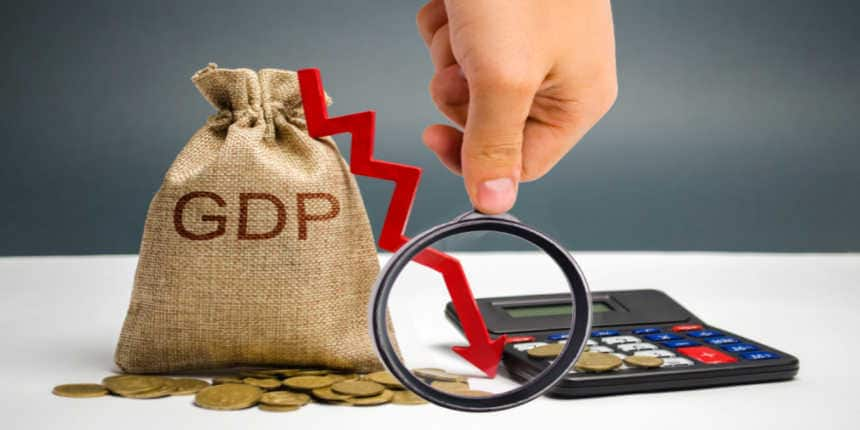GDP Full Form
The full form of GDP is Gross Domestic Product. This term is the total monetary or market value of all kinds of finished products which are produced within the boundaries of the country for a specific time. It is considered the health status of the country. In India, GDP majorly depends upon the three sectors that are agriculture, manufacturing, and service.
- Types Of GDP
- Nominal GDP
- Real GDP
- Methods Of Measuring GDP
- Income System
- Expenditure System

The growth rate of GDP shows the measures of the economic growth of a country. An increase in GDP leads to an increment in the living standard of people continuously. GDP rate also helps economists to consider the measures of the size of the economy of the country. In short, we can term GDP as a specific measure of overall domestic output.
Types Of GDP
Most popularly GDP is categorized into two types: Nominal GDP and Real GDP.
Nominal GDP
Nominal GDP is defined as the estimation of the economy’s total production in an economy, including the current prices in the calculation of GDP. In Nominal GDP, all finished goods and services are valued at the prices at which they are sold during the year. In the comparison of GDP of two or more years, we use Real GDP value because If we take nominal GDP it will fluctuate due to the influence of inflation.
Real GDP
In Real GDP, GDP value can take the measure of adjustment of inflation. It reflects goods and services produced in an economy produced at constant prices in the year, this saves from the impact of fluctuation in prices of goods and services every year due to inflation and deflation.
While comparing the Real GDP, we take the base year first and then compare it with the present year's GDP or any year which is asked.
Methods Of Measuring GDP
GDP is measured in three ways which are Income System, Expenditure System, and Output System.
Income System
In this system, estimation is taken on overall earned revenue received in production factors (i.e., labour, capital, etc.) within the boundaries of the country.
GDP = A + T - S,
Where, A= GDP at Factor expenses
T= Taxes
S= Subsidies
Expenditure System
It includes expenditures incurred on goods and services by individuals within the country.
GDP = C + I + G + NX
Where C = consumption expenditure of an individual
I = Firm’s investment
G= Government Expenditure
X= Exports
M= Imports
NX= net exports (X - M)
Other Related Full Form -
Frequently Asked Questions (FAQs)
GDP is the total monetary or market value of all kinds of finished products which are produced within the boundaries of the country for a specific time.
An increase in GDP leads to an increment in the living standard of people continuously. GDP also helps economists to consider the measure of the size of the economy of the country.
Nominal GDP is defined as the estimation of the economy’s total production in an economy, including the current prices in the calculation of GDP. In Nominal GDP, all finished goods and services are valued at the prices at which they are sold during the year.
In Real GDP, GDP value can take the measure of adjustment of inflation. It reflects goods and services produced in an economy produced at constant prices in the year, this saves from the impact of fluctuation in prices of goods and services every year due to inflation and deflation.
In this system, estimation is taken on overall earned revenue received in production factors (i.e., such as labour, capital, etc.) within the boundaries of the country.
GDP = A + T - S,
Where, A= GDP at Factor expenses
T= Taxes
S= Subsidies
It includes expenditures incurred on goods and services by individuals within the country.
GDP = C + I + G + NX
Where C = consumption expenditure of an individual
I = Firm’s investment
G= Government Expenditure
X= Exports
M= Imports
NX= net exports (X - M)